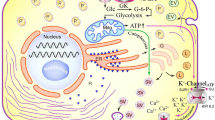Abstract
The effect of alloxan-induced diabetes on glutathione peroxidase (GSH-Px) activity in sciatic nerve of mice has been studied. We have found, 7 days after alloxan treatment, a significant decrease in this enzymatic activity in the cytosol of sciatic nerve of diabetic mice, and moreover, that these changes remained unaltered up to 21 days after alloxan injection. No modification in the glutathione content of sciatic nerve of diabetic mice was observed throughout the experiment when compared with controls. The decrease in GSH-Px activity in this tissue shows a good correlation with the increase of blood glucose levels throughout the experiment. It is hypothesized whether a combination of mechanisms could be involved in this decrease of GSH-Px activity and if oxygen radicals might be the common mediators of these processes.
Similar content being viewed by others
References
Low, P. A., Tuck, R. R., and Takeuchi, M. 1987. Nerve microenvironment in diabetic neuropathy. Pages 266–278,in Dyck, P. J., Thomas, P. K., Asbury, A. K. and Winegrad, A. I. (eds.), Diabetic neuropathy, Saunders, Philadelphia.
Carroll, P. B., Thornton, B. M., and Greene, D. A. 1986. Glutathione redox state is not the link between polyol pathway activity andmyo-inositol-related Na+-K+-ATPase defect in experimental diabetic neuropathy. Diabetes 35:1282–1285.
Low, P. A. and Nickander, K. A. 1991. Oxygen free radical effects in sciatic nerve in experimental diabetes. Diabetes 40:873–877.
Romero, F. J., Monsalve, E., Hermenegildo, C., Puertas, F. J., Higueras, V., Nies, E., Segura-Aguilar, J., and Romá, J. 1991. Oxygen toxicity in the nervous tissue: comparison of the antioxidant defense of rat brain and sciatic nerve. Neurochem. Res. 16:157–161.
Rahman, I., Massaro, G. D., and Massaro, D. 1992. Exposure of rats to ozone: evidence of damage to heart and brain. Free Radical Biol. Med. 12:323–326.
Xue, J.-Y., Liu, G.-T., Wei, H.-L., and Pan, Y. 1992. Antioxidant activity of two dibenzocyclooctene lignans on the aged and ischemic brain in rats. Free Radical Biol. Med. 12:127–135.
Crouch, R. K., Kimsey, G., Priest, D. G., Sarda, A., and Buse, M. G. 1978. Effect of streptozotocin on erythrocyte and retinal superoxide dismutase. Diabetologia 15:53–57.
Greene, D. A., Sima, A. A. F., Pfeifer, M. A., and Albers, J. W. 1990. Diabetic neuropathy. Annu. Rev. Med. 41:303–317.
Low, P. A., Logerlund, T. D., and McManis, P. G. 1989. Nerve blood flow and oxygen delivery in normal, diabetic, and ischemic neuropathy. Int. Rev. Neurobiol. 31:355–438.
Brownlee, M., Cerami, A., and Vlassara, H. 1988. Advanced glycosylation end products in tissue and the biochemical basis of diabetes complications. N. Engl. J. Med. 318:1315–1321.
Hunt, J. V., Dean, R. T., and Wolff, S. P. 1988. Hydroxyl radical production and autoxidative glycosylation. Biochem. J. 256:205–212.
Lawrence, R. A., Parkhill, L. K., and Burk, R. F. 1978. Hepatic cytosolic non-selenium dependent glutathione peroxidase activity: its nature and the effect of selenium deficiency. J. Nutr. 108:981–987.
Penefsky, H. S., and Bruist, M. F. 1984. Adenosine triphosphatases. Vol. IV, Pages 324–335,in Bergmeyer, H. U. (ed.), Methods of Enzymatic Analysis, Verlag Chemie, Weinheim.
Brigelius, R., Muckel, C., Akerboom, T. P. M., and Sies, H. 1983. Identification and quantitation of glutathione in hepatic protein mixed disulfides and its relationship to glutathione disulfide. Biochem. Pharmacol. 32:2529–2534.
Kunst, A., Draeger, B., and Ziegenhorn, J. 1984. D-Glucose, Vol. VI, Pages 163–172,in Bergmeyer, H. U. (ed.), Methods of Enzymatic Analysis, Verlag Chemie, Weinheim.
Lowry, O. H., Rosebrough, N. J., Farr, A. L., and Randall, R. J. 1951. Protein measurement with the Folin phenol reagent. J. Biol. Chem. 193:265–275.
Hermenegildo, C., Felipo, V., Miñana, M.-D., and Grisolía, S. 1992. Inhibition of protein kinase C restores Na+, K+-ATPase activity in sciatic nerve of diabetic mice. J. Neurochem. 58:1246–1249.
Trüeb, B., Holenstein, C. G., Fisher, R. W., and Winterhalter, U. H. 1980. Nonenzymatic glycosylation of proteins. J. Biol. Chem. 255:6717–6720.
Schnider, S. L., and Kohn, R. R. 1980. Glucosylation of human collagen in aging and diabetes mellitus. J. Clin. Invest. 66:1179–1181.
Cohen, M. P. (ed.) 1986. Diabetes and Protein Glycosylation. Springer Verlag, New York.
Adachi, T., Ohta, H., Hirano, K., Hayashi, K., and Marklund, S. L. 1991. Non-enzymic glycation of human extracellular superoxide dismutase. Biochem. J. 279:263–267.
Perchellet, J.-P. and Perchellet, E. M. 1989. Antioxidants and multistage carcinogenesis in mouse skin. Free Radical Biol. Med. 7:377–408.
Pigeolet, E., Corbisier, P., Houbion, A., Lambert, D., Michiels, C., Raes, M., Zachary, M.-D., and Remacle, J. 1990. Glutathione peroxidase, superoxide dismutase and catalase inactivation by peroxides and oxygen derived free radicals. Mech. Age. Dev. 51:283–297.
Wali, R. K., Dudeja, P. K., Bolt, M. J. G., Sitrin, M. D., and Brsitus, T. A. 1990. Correction of abnormal small intestinal cytosolic protein kinase C activity in streptozotocin-induced diabetes by insulin therapy. Biochem. J. 272:653–658.
Schäfer, A., Wieser, R. J., Romero, F. J., and Oesch, F. 1990. Reduction of glutathione content by 12-O-tetradecanoylphorbol-13-acetate in confluent but not in sparse cultures of human diploid fibroblasts. Carcinogenesis 11:697–699.
Romero, F. J., Llopis, J., Felipo, V., Miñana, M.-D., Romá, J., and Grisolía, S. 1992. H7, a protein kinase C inhibitor, increases the glutathione content of neuroblastoma cells. FEBS Lett. 303:19–21.
Author information
Authors and Affiliations
Rights and permissions
About this article
Cite this article
Hermenegildo, C., Raya, Á., Romá, J. et al. Decreased glutathione peroxidase activity in sciatic nerve of alloxan-induced diabetic mice and its correlation with blood glucose levels. Neurochem Res 18, 893–896 (1993). https://doi.org/10.1007/BF00998274
Received:
Issue Date:
DOI: https://doi.org/10.1007/BF00998274



